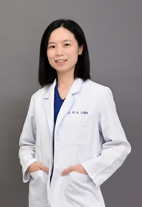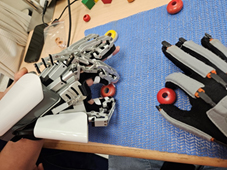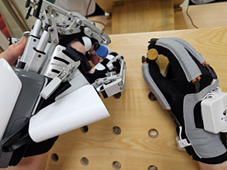
Stroke often leaves patients with significant sequelae. Among these,
impaired upper limb function is one of the most common, including unilateral
weakness (hemiplegia) and abnormal muscle tone. These impairments affect
patients' daily lives, significantly reducing their quality of life.
With the rapid advancements in technology, the field of rehabilitation is
also witnessing new developments. However, the physiological structure of human
fingers is intricate and complex, and past rehabilitation equipment has often
lacked the precision to target finger movements for training. This has
presented a significant challenge for many stroke patients in regaining the
basic yet crucial ability to grasp.
To overcome this predicament, our hospital has introduced an innovative
rehabilitation device developed through a Ministry of Science and Technology
project—the "Mirror Hand (Robot)." The Mirror Hand combines multiple
therapeutic modes, using a sophisticated robotic hand to assist and guide the
patient's affected hand in performing exercises. It integrates visual, proprioceptive,
and motor imagery feedback mechanisms to accelerate brain reorganization and
functional recovery. Currently, literature has confirmed the significant
benefits of Mirror Hand therapy in improving upper limb function and promoting
brain recovery in stroke patients.
How Does the Mirror Hand Robot Work?
The working of the Mirror Hand robot is quite intuitive and precise:
- Precise Capture by the
Sensing Glove: First, the patient wears a highly sensitive sensing
glove on their unaffected hand. This glove accurately detects every subtle
movement of the unaffected hand, including finger flexion, extension, and
even thumb opposition.
- Seamless Signal
Transmission: The movement signals captured by the sensing glove
are transmitted in real-time and accurately to the control system of the
"exoskeleton robot hand" worn on the affected hand via a
sophisticated detection system.
- Precise Assistance from
the Robot Hand: Upon receiving the signals, the precise motors
within the exoskeleton robot hand accurately assist and guide the affected
hand to perform the same movements as the unaffected hand.
- Integration of Daily
Life Activities: A significant advantage of the Mirror Hand robot
training is its ability to easily incorporate simple daily life movements.
For example, under the guidance of a therapist, patients can practice
using the robotic hand to assist in picking up objects of different sizes
and shapes, reaching for objects, and placing them.
Diverse Training Modes: Meeting the Needs of Different
Rehabilitation Stages
The Mirror Hand robot offers a variety of carefully designed training
modes:
- Passive Joint Movement Mode: In this mode, the
robotic hand provides continuous passive joint movement training. The
robot can automatically guide the affected hand's individual fingers or
all five fingers simultaneously in repetitive opening and closing
movements. This mode is particularly suitable for the early stages when
the patient has limited voluntary movement, helping to maintain joint
mobility, promote blood circulation, and reduce muscle tightness.
- Mirror Mode -
Individual Finger Flexion/Extension & Thumb Opposition: This is the core mode
of mirror therapy. By making movements with the unaffected hand wearing
the sensing glove, the affected hand performs the same movements
synchronously. This mode can target the flexion and extension of
individual fingers, as well as practice thumb opposition with other
fingers, improving fine motor control.
- Mirror Mode - Bilateral
Task-Oriented Training: In this advanced mode, therapists can design
various training tasks with clear goals based on the patient's hand
function level. For example, using the robotic hand to assist patients in
picking up building blocks, stacking objects, and practicing other daily
life activities. More importantly, this mode can be combined with commonly
used training tools in the therapy room, such as objects of different
materials and sizes, allowing the robot hand to be quickly integrated into
existing treatment strategies.
Therapeutic Benefits of the Mirror Hand Robot
The Mirror Hand robot is suitable for patients with hand dysfunction
caused by various central or peripheral nervous system injuries. Through
consistent and appropriate Mirror Hand robot training, the following benefits
can be expected:
- Improved Active Distal
Movement of the Affected Side: More effective
recovery of active finger movement ability.
- Promoted Normalization
of Tone on the Affected Side: Reduction or improvement of abnormal muscle tone in
the affected limb.
- Improved Joint Mobility
on the Affected Side: Maintenance and increase in the range of motion of
the affected hand joints.
Basic Requirements for Using the Mirror Hand Robot
To ensure the safety and effectiveness of the training, the following
basic criteria need to be met before using the Mirror Hand robot:
- Fingers Can Be Opened
Without Excessive Effort: Passive range of motion of the affected fingers is
acceptable, and movement can be performed with robotic assistance.
- No Skin wound: No wound on the skin
when wearing the robotic hand to avoid infection or other discomfort.
- Sensation Present in
the hand: Some sensory function is the basis for motor
learning and feedback.
- Ability to Understand
Instructions: Able to comprehend the therapist's guidance and
cooperate in completing the training.
- Ability to Tolerate
Sitting for More Than 50 Minutes: A typical treatment
session lasts approximately 50 minutes, and patients need to have
sufficient endurance.
Opening a New Chapter in Hand Rehabilitation
Occupational therapists will conduct a detailed evaluation based on the
patient's motor recovery status and set individualized training programs
according to their specific recovery progress. During the training process,
occupational therapists will provide timely and appropriate guidance and
feedback to achieve the best rehabilitation outcomes.
If you or your family and friends have hand function rehabilitation needs,
you are welcome to register for our hospital's Rehabilitation Department
outpatient clinic. After a professional evaluation by a doctor and a treatment
referral, you can schedule an appointment with the Occupational Therapy
Department of the Rehabilitation Department. Let us work together to utilize
this advanced technology to regain hand function, improve quality of life, and
once again take control of an independent life.

